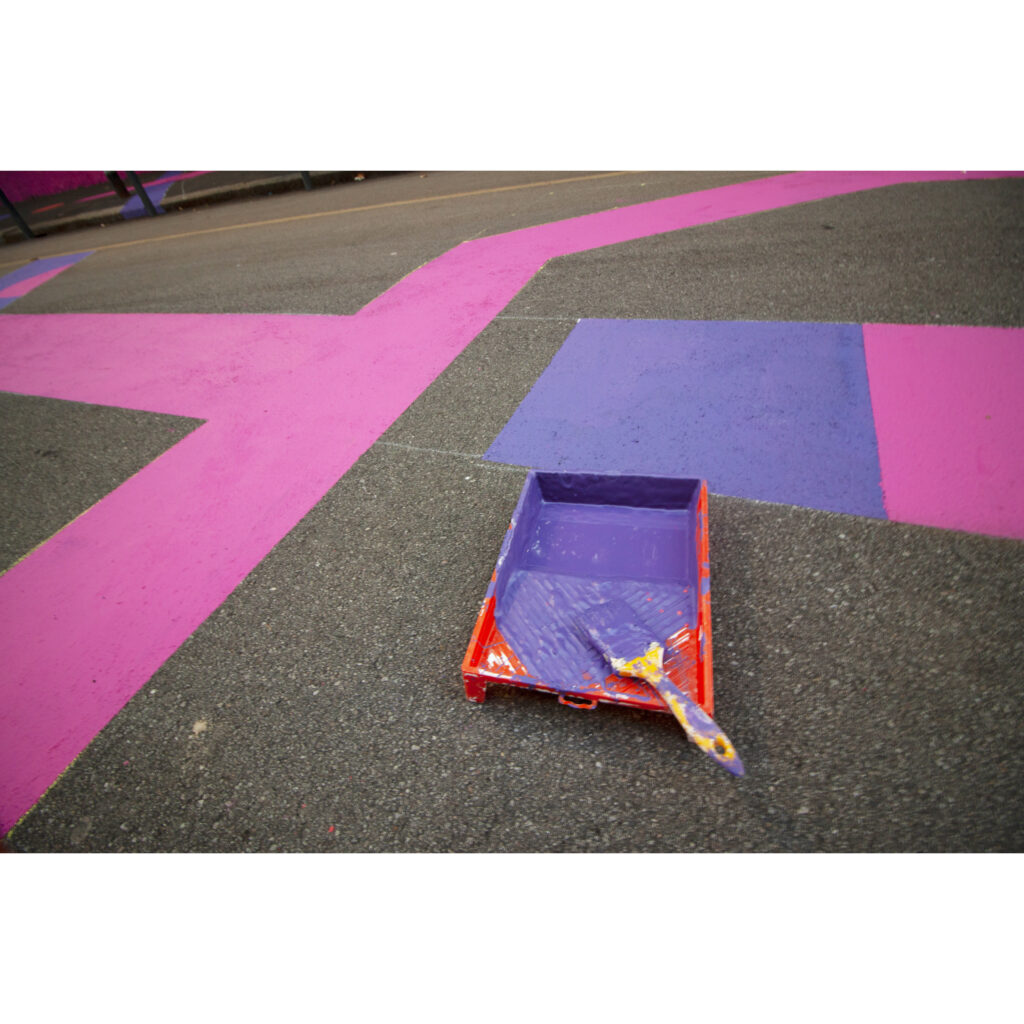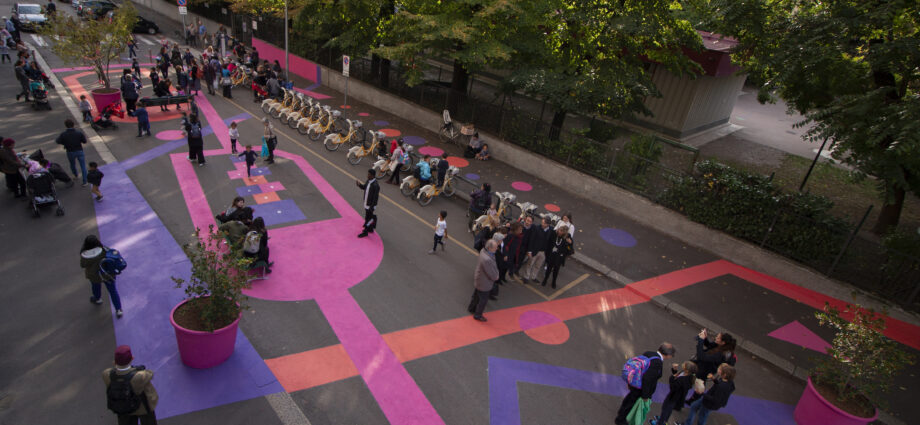“Colora la strada” is a tactical urbanism project completed in 2019 thanks to the collaboration of Apicultura, the municipality of Milano, Municipio 3 of Milano, Retake Milano, Via Reni kindergarten and the people of the neighborhood.
“The success of the project helped to build a bond with the local administration that recognized the importance of citizens’ involvement and the need to build more shared processes when designing public spaces.“
Apicultura

In 2018, the municipality of Milan closed to vehicles traffic the street in front of the kindergarten to provide an outdoor public space in front of the school that could be used by children and families after the lessons and school-time.
This new public space came without any urban furniture or green areas, therefore the municipality decided to implement an enhancement project to improve the place and make it more engaging for children. Instead of adopting a top-down approach and develop the project internally, the municipality built a network of stakeholders, citizens and students in order to co-design the space.
We have been involved as a collective to transform and integrate the needs and visions developed during the ‘listening’ process into a design for the place aiming also to foster the enhancement of citizens in the maintenance of the area. We have chosen a straightforward approach with a neat design based on simple forms and strong colours based on the artworks of Kandinsky. This allowed us to clearly divide the three main play areas for the kids and make the space immediately recognizable. The choice of the games to be placed within the design has been done through workshops with their users, the kids, by recreating the design in a classroom and letting them play while observing their reactions and collecting their votes on their favorites.
Three games have been chosen and while finalizing the project we included at least one bench and one tree for each play area merging them in the design. After completing the street painting thanks to the help of the citizens and Retake Milano (a local NGO) through a collective workshop, a ‘patto di collaborazione’ (common agreement) has been signed to co-manage the space and involve people in future upgrades.
-Apicultura Studio

Pedestrian Space: The actors for this project represent a dynamic spectrum of actors within the community in a type of cooperation that we view as so valuable. There was a collaboration from the municipal level (Milan), agency (your studio), non-profit (Retake Milan Association), volunteers and community (school). Can you share more on this?
Apicultura: Yes, the project has been developed by our collective in cooperation with Retake Milano which also supported the participatory workshops with the students from the school. The municipality supported the project through public tenders.
Pedestrian Space: The project focuses on tactical urbanism with inspiration from avant garde artists of the early 20th century. How was this specific artistic angle decided upon?
Apicultura: The decision mostly came from a personal interest we had as a collective at the time of the proposal. We made some considerations about the use of neat shapes and colours and their relations on the space of an artwork and how to translate them on a canvas as big as a street. Avant-garde artists had the capacity to bring the art outside the traditional thinking or spatial ‘boxes’ to make it a “social” message which was among our aims for the Via Reni project.

“We see our role as design professionals as ‘translators’ that share the lead of the process but have to translate expectations, needs, desires into a spatial transformation of a place.”
apicultura
Pedestrian Space: One component of this project was a participatory workshop with the students of the primary school at Via Reni. Can you share more about this process -how many times the students were met with, what the energy of the workshops was, etc?
Apicultura: We decided to concentrate the experience to just one participatory workshop to keep a higher focus and energy with the kids. We involved them in recreating the outside street inside one of their classrooms and we draw the playgrounds we were thinking to have outside. We played together and explored the different possibilities of the playgrounds (as an open-air twister, the leapfrog,…) and then asked them to choose and vote their favorites which have then been placed within the overall design scheme elaborated by us. There was a lot of energy and enthusiasm as the kids were very keen on being involved directly in choosing the games they would have liked to play in front of their school.

Pedestrian Space: The outcome of the workshop that the students were able to participate in the design process and choose their favorite games that would then be incorporated into the design is really fantastic. What were some of the other outcomes of their participation?
Apicultura: The sense of belonging has immediately grown and so its daily use. Kids are accustomed to also staying there after the end of daily classes instead of going directly home and parents are extremely happy to have a space where they can meet while kids are playing. The success of the project helped to build a bond with the local administration that recognized the importance of citizens’ involvement and the need to build more shared processes when designing public spaces. Hopefully other similar projects will happen in the future. We think that an important outcome has been to demonstrate that such projects are meant to show different possibilities to use the space and that not necessarily the transformation has to be radical or irreversible to be effective.

“Instead of adopting a top-down approach and develop the project internally, the municipality built a network of stakeholders, citizens and students in order to co-design the space.”
Apicultura
Pedestrian Space: Had your agency done participatory workshops prior to this?
Apicultura: Single members of the agency had experience in participatory workshops on various topics but it was the first moment we have done it as a collective. Prior experiences were related with participatory self-building workshops in public spaces in Italy and abroad, participatory mapping and social analysis in neighbourhoods of Milano and the organization of cultural shared events at the Politecnico di Milano university.

Pedestrian Space: What does your agency see as the value of the collaboration between actors from municipality, non-profit, community as well as design professionals?
Apicultura: We believe design and architecture in themselves are not merely a combination of art and science but have a strong social impact. The quality of the space where we live is definitely a component of a more just and sustainable society. In this sense, we consider the collaboration between the different institutions and formal or informal associations as a key part of the design process. We see our role as design professionals as ‘translators’ that share the lead of the process but have to translate expectations, needs, desires into a spatial transformation of a place.

Pedestrian Space: What was the added importance of this project’s enhancement of a pedestrian environment in an area with so many students?
Apicultura: The project contributed to give a new role to a stretch of road that otherwise would not have served as a playground but only as a crossing and transit space. Even before the Covid-19 pandemic, which demonstrated the importance of having good quality open spaces for citizens and children where to spend time, study, or learn, the possibility to give to these kids a space to stop after the end of the school day and extend their relations beyond school’s hours seemed to us a fundamental achievement for the project. Moreover, the presence of the school allowed a direct and immediate appropriation of the space by its users.

Visit Apicultura online at http://apicultura.studio/

